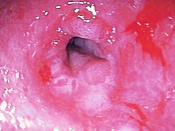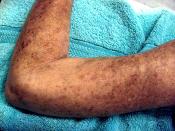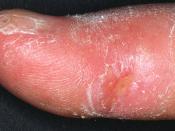Scleroderma means hard skin and is a disease categorized as an autoimmune disease, and it is also considered a rheumatologic disorder. This disease involves the abnormal growth of the connective tissue, which supports the skin as well as the internal organs. Scleroderma affects the body's skin, bones, muscles, gastrointestinal tract, kidneys, and lungs, depending on the severity of the condition. Localized and systemic are the two classes of scleroderma. Localized scleroderma has two variant forms: morphea and linear. Systemic also has two variant forms: limited and diffuse.
Localized scleroderma is limited to the skin and related tissue. This class does not affect the internal organs, nor can it progress into a more severe form of scleroderma. Often this condition may improve; eventually it may disappear; however, the damage that has occurred is permanent. Morphea and linear are variant forms of limited scleroderma.
These two variant forms are very similar in that they involve only patches or lines of thicken skin.
Morphea means form or structure. Linear means Line or band (Korn 4). These patches or lines can be found on the chest, stomach, or back, and are often reddish in color. Linear scleroderma is also often found on the forehead.
Systemic scleroderma is more severe form of scleroderma. This form of the disease not only includes the skin and tissue, but it also affects the blood vessels and internal organs. Systemic scleroderma is often referred to as CREST: Calcinosis, Raynaud's phenomenon, esophageal dysfunction, slerodactyly, and telangiectasias (Simon 12). Patients with systemic scleroderma may experience one or all of these symptoms. Systemic scleroderma has two variant forms: limited and diffuse.
Limited scleroderma affects the fingers, hands face, arms, and legs. The skin becomes hard and very tight. Raynaud's phenonmenon is when the blood vessels in the limbs contract in response...


